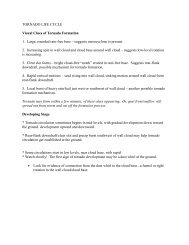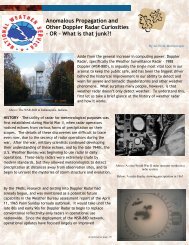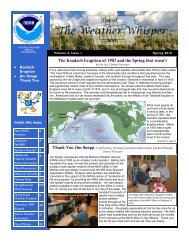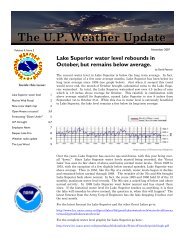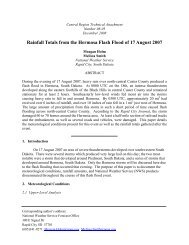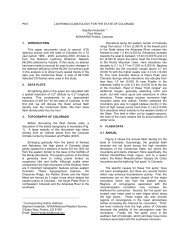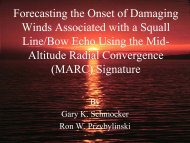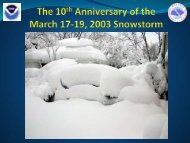A Grassroots Project at WFO Riverton - Central Region ...
A Grassroots Project at WFO Riverton - Central Region ...
A Grassroots Project at WFO Riverton - Central Region ...
You also want an ePaper? Increase the reach of your titles
YUMPU automatically turns print PDFs into web optimized ePapers that Google loves.
P A G E 4<br />
New Hail Criterion for Severe Thunderstorms<br />
An historic change to the NWS criterion to define the size of hail c<strong>at</strong>egorizing a thunderstorm as severe was implemented by selected<br />
we<strong>at</strong>her forecast offices in the central United St<strong>at</strong>es and Rocky Mountain region on April 1, 2009. The NWS <strong>Riverton</strong> office was a<br />
participant in this change, which has now been implemented n<strong>at</strong>ionwide. The old standard of three-quarter inch diameter hail for<br />
design<strong>at</strong>ing a thunderstorm severe has been replaced by the new standard of one inch diameter hail.<br />
For the past four years, the NWS offices in Kansas served as a test bed to<br />
measure the efficiency of using one inch diameter as the criterion for severe<br />
thunderstorms. One of the motiv<strong>at</strong>ions for this experiment was the perception<br />
th<strong>at</strong> numerous warnings for thunderstorms th<strong>at</strong> produced hail of little damage<br />
or was not unusual would cause the public to view these warnings as only a<br />
minor thre<strong>at</strong>. During the four-year Kansas project, customer feedback was<br />
collected with a very favorable response to the new criterion from emergency<br />
managers and the media. With the new criterion in place, public surveys<br />
concluded people were more likely to take action to protect themselves and<br />
their property. Another opinion voiced in the survey was th<strong>at</strong> many people<br />
were happier not having television programs interrupted as frequently.<br />
Forecasts for those thunderstorms producing hail less than one inch in diameter<br />
and/or wind gusts less than 58 mph, but still capable of producing a thre<strong>at</strong> to<br />
lives and property, are detailed in NWS short term forecasts (for minor thre<strong>at</strong><br />
events) and significant we<strong>at</strong>her advisories (for storms near severe thresholds).<br />
Another important thing to remember when reporting hail is to reference coin<br />
Meteorologists Conduct Research to Possibly Improve Severe Thunderstorm Detection<br />
Research comparing radar d<strong>at</strong>a, height of the freezing level, and hail reports is being conducted by meteorologists <strong>at</strong> the NWS<br />
<strong>Riverton</strong> office. The methodology is similar to th<strong>at</strong> used by meteorologists <strong>at</strong> the NWS Des Moines, IA office who sought a better<br />
way to determine which thunderstorms were producing severe sized hail.<br />
Researchers can evalu<strong>at</strong>e storm <strong>at</strong>tributes on radar by loading past thunderstorm<br />
events into the NWS <strong>Riverton</strong>’s We<strong>at</strong>her Event Simul<strong>at</strong>or (WES). The WES<br />
allows researchers to replay events and evalu<strong>at</strong>e specific thunderstorm<br />
characteristics using radar d<strong>at</strong>a. Similarly, the WES can be used as a training<br />
resource by placing forecasters into a real-time scenario to improve diagnostic,<br />
interpret<strong>at</strong>ion, and software oper<strong>at</strong>ion skills.<br />
Thunderstorms th<strong>at</strong> produced hail reports of <strong>at</strong> least 0.75 inches in diameter<br />
(since 2002) are being evalu<strong>at</strong>ed for the study. Past d<strong>at</strong>a from we<strong>at</strong>her forecast<br />
models is then reviewed to determine the approxim<strong>at</strong>e height of the freezing<br />
level during the hailstorm. The d<strong>at</strong>a is then plotted on a graph to determine if<br />
any strong correl<strong>at</strong>ion exists between wh<strong>at</strong> is seen on radar and wh<strong>at</strong> size hail<br />
falls on the ground. Researchers have completed review of all storms during the<br />
period 2002 through 2009. The hope now is to determine if there are some<br />
helpful radar sign<strong>at</strong>ures pertinent to western Wyoming where forecasters might<br />
better distinguish between severe and non-severe thunderstorms. Potentially this<br />
would help improve detection of severe thunderstorms while <strong>at</strong> the same time<br />
limiting the number of warnings issued for storms th<strong>at</strong> are non-severe.<br />
Tree damage <strong>at</strong> the <strong>Riverton</strong> Country Club following a 74 mph<br />
wind gust on July 27, 2009. At least a dozen m<strong>at</strong>ure trees<br />
were damaged on the course.<br />
sizes or the sizes of various sports balls (e.g., ping pong ball, golf ball, tennis ball, baseball). Also, be sure to distinguish hail th<strong>at</strong> is<br />
quarter-sized (coin), denoting one inch diameter hail, and th<strong>at</strong> of one-quarter inch diameter hail (roughly pea size). We hope this<br />
new criterion for hail in a severe thunderstorm serves you and your customers well, and we invite your feedback on this fundamental<br />
change to severe thunderstorm criteria.<br />
Hail up to the size of tennis balls fell on the east side of<br />
Greybull around 5:15 p.m. on August 7, 2009. Severe<br />
thunderstorm warnings and a tornado warning were issued<br />
well in advance of the storm.




